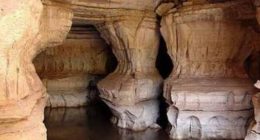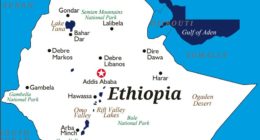Ethiopia has many beautiful landscapes and unique sites for travelers to explore. From North to south, east to west, the country is home to vibrant and culturally rich cities, along with incredible natural wonders. There are more than 10 World Heritage Sites in Ethiopia. Here are few.
Aksum
A large site containing several very high tombs. The ruins of the city of Aksum, dating from the 1st to the 13th century, mark the heart of ancient Ethiopia and what was the “most powerful state between the Eastern Roman Empire and Persia”. It includes monolithic obelisks, giant steel, royal tombs, and ruins of former castles.
Fasil Ginb
A picture of a four-storey stone castle surrounded by a grassy lawn and four cylindrical towers. The fortress was the residence of the Ethiopian emperors during the 16th and 17th century. The city remains, which feature buildings with Hindu and Arab influences, were later remodelled with Baroque-style architecture by Jesuit missionaries.
Harar Jugol, the Fortified Historic Town
The Harar city wall (jugol). The city is on a plateau and surrounded by gorges and savanna. It contains 82 mosques, 102 shrines, and unique interior design in the townhouses. Harar is said to be the fourth-holiest city of Islam.
Konso Cultural Landscape
A Konso Waga sculpture. The site features 55 kilometres (34 mi) of stonewalled terraces and fortified settlements in the Konso highlands of Ethiopia.
Lower Valley of the Awash
A picture of a waterfall to the right, shooting water into the side of a rapid flowing river. Palaentological findings from at least four million years ago, such as Lucy, give evidence of human evolution.
Lower Valley of the Omo
A view of a lightly muddy river. The prehistoric site near Lake Turkana is the location of many fossil findings, such as Homo gracilis.
Rock-Hewn Churches, Lalibela
A picture of a pick-coloured building intact inside of a large, square hole. The site contains twelve medieval rock hewn churches from the 13th century.
Simien National ParkIn danger
A mountain landscape with deep precipices. The eroded Ethiopian plateau comprises jagged mountain peaks, deep valleys, and sharp precipices dropping about 1,500 m (4,900 ft). The decrease of the Walia Ibex, bushbuck, and bushpig populations, as well as an increase of the human population in the park prompted the World Heritage Committee to place it on their List of World Heritage in Danger in 1996.
Tiya
A view of several tombstones lined up side-by-side. The archaeological site contains 36 monuments, which includes 32 covered with symbols hard to decrypt.



